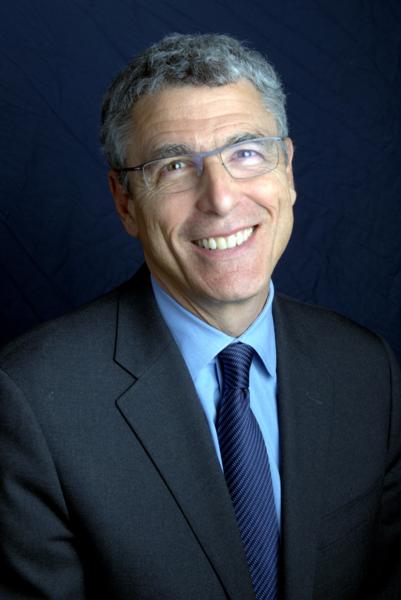Art exists beyond the binary of rational and irrational. Art has the ability to reshape our perspectives on our world - which is precisely why great artists have designed synagogues, museums, and other sacred spaces - including... the mishkan, the Israelite's portable ark.
Three ways to listen:
- Listen to the full podcast below
- Subscribe to the podcast on Apple Podcasts
- Suscribe to the RSS feed
Transcript
[URJ Intro:] Welcome back to "On The Other Hand: Ten Minutes of Torah," a podcast presented by ReformJudaism.org. Each week, Rabbi Rick Jacobs, the President of the Union for Reform Judaism, shares a bit about the Torah portion in about 10 minutes or less. This week, Rabbi Jacobs teaches us about Parashat P'kudei, the last portion in the Book of Exodus. He asks us to think about how art and design might influence spirituality and place.
[Rabbi Rick:] This week we focus our attention on Parashat P'kudei, the last parashah of the Book of Exodus. You'll remember that for the five last parshiyot in the Book of Exodus, [they] are focused on the creation of the first praying place in Judaism known as the Mishkan, the Tabernacle, and it's an activity that the entire community participates in. They donate the materials and the substances that are used in the construction. They are the artisans, and they shape a very modest, very beautiful, and a very portable sanctuary that they take with them on their journeys. The person who is either the construction manager and architect is a man named B'tzalel, and B'tzalel plays a very unique role in the creation of this first praying place. First of all, God really dictates the rough contours of its size and its materials, but this individual named B'tzalel seems to have a very unique gift to bring everyone together, because I can only imagine a large group of human beings, let alone Jewish people, trying to just build something together at a very tense moment there. Not that long before, they're slaves and B'tzelel's able to accomplish this.
Amazingly, I think it awakens the question of art and Judaism, whether it be an architect or a sculptor or a painter or a composer or a dancer or a choreographer. And it really, I think, asks us to think about the way in which art can be a very powerful expression of spirituality. So I would just say that I think for many of us, when we think about art and Jewish life, or art and spiritual life, we kind of think that maybe art's the parsley on the plate of dinner. You know, it's there, it makes things look pretty, but you don't really need that parsley -- you could eat the fish, or the steak, or the tofu and the vegetables without that parsley, it's there to be decorative. I'd like to make the case in this week's podcast, the last one in the Book of Exodus for this year, that art isn't the parsley. It can actually be one of the most powerful ways for us to experience the holy. And I'll just use the example [in] one of my favorite books on religion, a book by Rudolf Otto called "The Idea of the Holy." He published it in 1917, and in it he points out that we oftentimes think that there are two categories for human experience: the rational and the irrational. The rational goes according to the laws of logic, and irrational, it's kind of out of bounds, it's not really within that. He identifies something, a third way called the non-rational. And in many ways, spirituality, the experience of the holy, is not rational, it's not logical, but it's not anti-rational either. It's another mode of experience, and very often art is that way.
I think particularly of some of the great works of art that have reshaped how we think. The most famous one for me is Picasso's famous portrait of Gertrude Stein. In the spring of 1906, Picasso began this portrait of his friend and his patron Gertrude Stein. When Picasso finished the painting, there were people who criticized it and said, "that doesn't look anything like her," and Picasso very simply answered, "Oh, but it will." Meaning, that he was completely confident that his interpretive portrait of his friend and patron would over time define her much more than her actual physical appearance that her friends knew. And if we think about that, that art can change and reshape our perspectives on the world. And that's been the case in a number of instances where great artists have actually designed synagogues. I use the example of Frank Lloyd Wright, who designed a synagogue, Beth Sholom in Elkins Park. And when they asked the great architect what he was trying to accomplish he said the following.
He said, "We want to build an American synagogue for Jews to worship in, and we want to create the kind of building that people on entering it will feel as if they were resting in the very hands of God." Now if you've been to that sanctuary, it is incredibly tall. The internal experience -- they are vertical metaphors. And you have this experience of grandeur and majesty, and he's trying as an architect to create an intimate experience of spirituality, a feeling connected to God.
Well, I think that's what the biblical text was describing -- a very intimate space where God's very presence was located right between the cherubim on the ark. So how is it that that's been the case? There have been others. I think of the great Sol LeWitt, one of the most remarkable contemporary artists who designed the sanctuary of Congregation Beth Shalom Rodfe Zesek in Chester, Connecticut. And if you've had a chance to visit that, just gorgeous the way the ceiling and the lines give one an expression of spirituality before a word has been uttered, before a melody has been sung. There's something spiritually edifying in the very architecture of that space. I'm very proud to say that Marcel Breuer, the great contemporary architect, was the consulting architect to a synagogue that I was privileged to lead for 20 years in Westchester, New York -- Westchester Reform Temple. And what Breuers set out to do, he said, you know, when I fly over communities and I looked down and I see a cathedral, it's in the shape of a cross. So it has a kind of celestial identity, is that I want a Jewish building that expresses something from above. So he helped to design the original building of Westchester Reform Temple in the shape of a Jewish star, the Magen David. And you know, we actually have a beautiful picture of a low flying plane over the synagogue, and you see the six points of the star. And it's quite striking. What wasn't quite so striking is that those six points were architecturally impossible to utilize, because we had classrooms that met in the points of the star but they were, you know, funny-shaped, and the noise bled out. So sometimes a brilliant idea can actually not be incredibly practical.
You have a couple of other examples. Louis Kahn, the great architect also in Westchester, New York. (Something about Westchester, New York here, friends...) Temple Bethel in Chappaqua, where he designed what is absolutely a compelling synagogue. They've now refurbished it, keeping some of the integrity.
And it's amazing the number of really remarkable architects who've wanted to take their hand at designing sacred space, not just for the accomplishment and to say, well, I've designed a museum, and I've designed an office building, and now I've designed a synagogue -- but frankly to do something different with that space. And I think of some of the architects who maybe down the road will -- I think of Michael Arad, the brilliant Israeli-American architect who designed the 9/11 memorial here in New York City. And I think of what would Michael Arad be able to do, if he had the opportunity to take his gifts and to shape with symbolism and practicality what a sacred space in the 21st century could be? Inspired by, you know, Parashat P'kudei, inspired by the notion of a place to gather the most sacred objects, the Ark of the Covenant, the eternal light -- the menorah, the way in which people gather together. These are all very powerful opportunities. And we can think of some of the great buildings that also had meaning that maybe weren't synagogues. I think of Jim Freed who designed the U.S. Holocaust Memorial in Washington, D.C. And I think of the way that building communicates some of the experience of the whole Shoah by the way that space and light are utilized.
So, the amazing talent of architects in particular to be able to help reorient us in the way that Picasso did with Gertrude Stein. How might a contemporary synagogue reorient us towards spirituality of today, not of 3000 years ago? One of the things that's clearly different is the architects of today's synagogues don't have to make it all portable. There's something very spiritually powerful about having one's the ritual home portable, that we're nomads, we take it with us. We had to be more modest. Now we can be more elaborate. But what are the ways in which we can use materials that are evocative?
I was in a synagogue just this last weekend, and there was a beautiful [pair of] lions holding the Ten Commandments that were clearly from a much older synagogue, and it turned out they were from the synagogue's original building, but they took that one artifact to give people a sense of continuity, even though the new building is very, very contemporary. So how do we build and make sacred space? Is it the material? Is it the symbolism, is the intention of the architect, of the builders, or is it the intention of the participant, the congregant, the seeker?
I have to say, the most beautiful sacred space I've ever witnessed was the Matisse Chapel in the south of France. The light is so spectacular, and the artist understood the way the light would come teeming into that space, illuminating some of the design on the walls. And I just think that for all of us who are yearning for a more powerful way to live and experience spirituality, that we would obviously do well to look to our great sages, to look to our sacred texts like the Torah and the Talmud and the medieval codes and the great mystical works like the Zohar. But I also think we need to invite more artists to be co-creators of the spaces and of the very ritual of our spiritual life. That of course includes those composers and those choreographers who understood ritual and make our experiences so unbelievably powerful. So in thinking about Rudolf Otto and the idea of the Holy, let's create through art and ritual and religious and spiritual yearning. Let's create the 21st century version of the Mishkan.
At the very end of the Book of Exodus, [where] we have the last sentence which says that once the work was done, God's very presence dwelt in the Tabernacle, a sign of divine favor. A sign that the work had been done in a most powerful way. I pray that that Holy Presence will rest in many of our spiritual dwellings and that we would find renewal and inspiration from them as we read the last verse of the book:
"When the cloud lifted from the Tabernacle the Israelites would set out on their various journeys. But if the cloud did not lift, they would not set out until such time as it did lift. For over the Tabernacle a cloud of the Eternal rested by day, and a fire would appear in it by night in view of all the House of Israel throughout their journeys. L'enei chol beit yisrael b'chol ma'asei'hem." And so we say together when we conclude a book of the Torah, we say "chazak chazak v'nithazek." May we be strengthened with our continued study of this sacred book, and I look forward to next week's podcast when we will begin together the Book of Leviticus.
[URJ Outro:] Thanks for joining us for this week's episode of "On the Other Hand: Ten Minutes of Torah." If you liked what you heard today, and we hope you did, you can find new episodes each week at ReformJudaism.org and on Apple Podcasts, where we would love for you to rate and review us. And you can visit ReformJudaism.org to learn more about all aspects of Judaism, including rituals, culture, holidays, and more. "On the Other Hand: Ten Minutes of Torah" is a project of the Union for Reform Judaism, a leading voice in the discussion of modern Jewish life.
Until next week -- l'hitraot!


 Apple
Apple Android
Android Stitcher
Stitcher